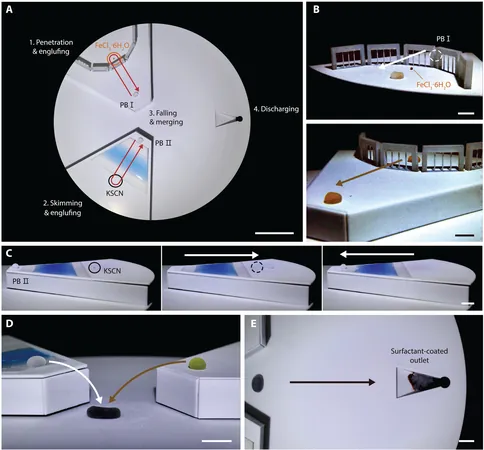
Revolutionary Liquid Robot Mimics Living Cells and Transforms the Future of Robotics!
2025-03-24
Author: John Tan
In a groundbreaking development, a collaborative research team has unveiled an astonishing liquid robot that can transform, separate, and merge—much like living cells. This remarkable innovation, published in the prestigious journal *Science Advances*, marks a significant leap forward in soft robotics.
Biological cells exhibit extraordinary abilities to deform, divide, seamlessly fuse, and interact with foreign substances. Although scientists have long aimed to replicate these functions in artificial systems, traditional rigid robots have struggled to achieve the same level of flexibility and versatility inherent in biological organisms.
To tackle these difficulties, the research team created an innovative particle-armored liquid robot, encased in densely packed water-repelling particles. This ingenious design not only grants the robot the fluidity and deformability of liquids but also incorporates the structural integrity of solid materials, allowing it to endure high impacts and extreme compression, returning to its original form much like a droplet.
Led by prominent experts—including Professor Ho-Young Kim from Seoul National University, Professor Jeong-Yun Sun from Gachon University, and Professor Keunhwan Park—the team showcased the liquid robot's impressive capabilities. Reminiscent of the iconic liquid robot "T-1000" from the 1991 classic *Terminator 2*, this cutting-edge machine can navigate through metal bars, capture and transport particles, and merge with other liquid robots. It can glide effortlessly across both water surfaces and solid ground.
In breakthrough tests, the research team demonstrated that the liquid robot could carry out these tasks continuously while developing techniques to control its movements using ultrasound at various speeds. This could pave the way for a plethora of applications in biomedical and soft robotics fields, including targeted drug delivery and advanced therapeutic interventions within the human body.
What's more, its ability to flow through narrow spaces could allow it to operate in large numbers inside intricate machinery, traverse rough terrains, and carry out crucial tasks in disaster zones—such as exploration, cleaning, and even chemical removal operations.
Hyobin Jeon, the lead author of the study, shared insights into their creative process, explaining, "Initially, we thought about encapsulating a spherical droplet with particles like traditional liquid marbles. However, by viewing it from a new angle, we decided to coat an ice cube with particles and melt it, greatly enhancing the stability of our liquid robots."
As the project progresses, Professor Ho-Young Kim anticipates even more advancements, stating, “We are currently developing technologies to allow the liquid robot to morph its shape dynamically using sound waves or electric fields.” Co-corresponding author Professor Jeong-Yun Sun also emphasized their ambitions for future applications: “We hope to boost the material functionality of this liquid robot for wider industrial use.”
This leap forward in robotics promises not only to revolutionize technology but also to alter significantly how we interact with living environments and complex machinery, making tasks safer and more efficient than ever before.


 Brasil (PT)
Brasil (PT)
 Canada (EN)
Canada (EN)
 Chile (ES)
Chile (ES)
 Česko (CS)
Česko (CS)
 대한민국 (KO)
대한민국 (KO)
 España (ES)
España (ES)
 France (FR)
France (FR)
 Hong Kong (EN)
Hong Kong (EN)
 Italia (IT)
Italia (IT)
 日本 (JA)
日本 (JA)
 Magyarország (HU)
Magyarország (HU)
 Norge (NO)
Norge (NO)
 Polska (PL)
Polska (PL)
 Schweiz (DE)
Schweiz (DE)
 Singapore (EN)
Singapore (EN)
 Sverige (SV)
Sverige (SV)
 Suomi (FI)
Suomi (FI)
 Türkiye (TR)
Türkiye (TR)
 الإمارات العربية المتحدة (AR)
الإمارات العربية المتحدة (AR)